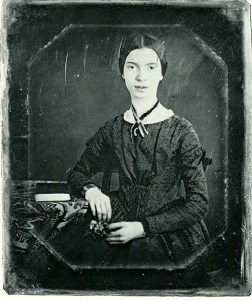The meaning of Dickinson’s great dog poem – analysed by Dr Oliver Tearle
‘A little Dog that wags his tail’ is not one of Emily Dickinson’s best-known poems, so a few words of analysis may help to clarify its meaning. It starts off sounding as though it’s going to be a dog poem – a sort of companion-piece to Dickinson’s celebrated poem about a cat – but then it quickly turns into a poem about something else entirely…
A little Dog that wags his tail
And knows no other joy
Of such a little Dog am I
Reminded by a Boy
Who gambols all the living Day
Without an earthly cause
Because he is a little Boy
I honestly suppose –
The Cat that in the Corner dwells
Her martial Day forgot
The Mouse but a Tradition now
Of her desireless Lot
Another class remind me
Who neither please nor play
But not to make a ‘bit of noise’
Beseech each little Boy –
In this poem, Emily Dickinson begins by considering the sheer delight of the dog wagging its tail, which is comparable to a little boy frolicking freely simply because he wants to – both the dog and the boy behave the way they do because that’s how they’re made, not for any more complex or cynical motive. Dickinson then switches to  thinking about the cat sleeping in a corner after a long day’s hunting a mouse, an activity which is likened to a war (‘martial Day’). She concludes the poem by considering a different ‘class’ of creature or person who doesn’t like to play or to provide pleasure to anyone else, and instead commands children to be quiet. In other words, she compares those adults who are of the opinion that children should be ‘seen and not heard’ with the children and animals whose entire purpose, their reason for being, seems to be to delight in the simple pleasures and to indulge in ‘play’. The dog is clearly aligned with the children’s play, while the cat belongs to the working adult who is too tired to enjoy such abandon.
thinking about the cat sleeping in a corner after a long day’s hunting a mouse, an activity which is likened to a war (‘martial Day’). She concludes the poem by considering a different ‘class’ of creature or person who doesn’t like to play or to provide pleasure to anyone else, and instead commands children to be quiet. In other words, she compares those adults who are of the opinion that children should be ‘seen and not heard’ with the children and animals whose entire purpose, their reason for being, seems to be to delight in the simple pleasures and to indulge in ‘play’. The dog is clearly aligned with the children’s play, while the cat belongs to the working adult who is too tired to enjoy such abandon.
This summary of ‘A little Dog that wags his tail’ brings home the central ‘meaning’ or ‘message’ of Dickinson’s poem: that there is something joyous in freedom and play which those who live their lives governed by a more prohibitive and joyless worldview (most adults, for instance). Losing the ability to take pleasure in small things is the first sign that one is losing one’s childhood innocence. Children and (some) animals both possess what the adult so often does not possess: a simplicity and innocence which enables them to revel in simple play for its own sake. Look at the way the Boy ‘gambols all the living Day’, with the word ‘gambols’ summoning animals as much as frolicsome children (‘gambol’ was often used of animals such as horses as they leap about energetically).
This is a poem about a dog, but only by virtue of its central analogy: first and foremost, ‘A little Dog that wags his tail’ is a poem about childhood freedom and play. As G. Stanley Hall wrote in a book on adolescence in 1904, in a quotation that would later be attributed to everyone from Benjamin Franklin to George Bernard Shaw, ‘Gross well says that children are young because they play, and not vice versa; and he might have added, men grow old because they stop playing, and not conversely, for play is, at bottom, growth, and at the top of the intellectual scale it is the eternal type of research from sheer love of truth.’
If you enjoyed this Emily Dickinson poem you may also enjoy our analysis of her classic poem about her encounter with Death, her celebrated snake poem, and her ‘loaded gun’ poem. If you want to own all of Dickinson’s wonderful poetry in a single volume, you can: we recommend the Faber edition of her Complete Poems.
The author of this article, Dr Oliver Tearle, is a literary critic and lecturer in English at Loughborough University. He is the author of, among others, The Secret Library: A Book-Lovers’ Journey Through Curiosities of History and The Great War, The Waste Land and the Modernist Long Poem.
Discover more from Interesting Literature
Subscribe to get the latest posts to your email.


Reblogged this on Janet's thread.
Hmmm, this is captivating